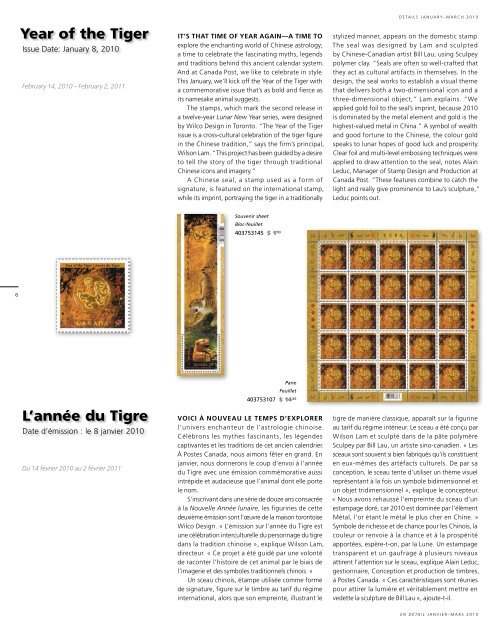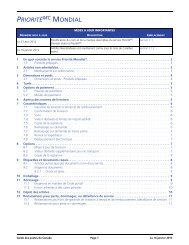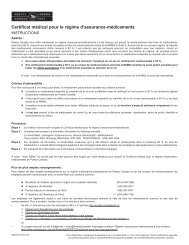Create successful ePaper yourself
Turn your PDF publications into a flip-book with our unique Google optimized e-Paper software.
6<br />
Year of the Tiger<br />
Issue Date: January 8, 2010<br />
February 14, 2010 – February 2, 2011<br />
L’année du Tigre<br />
Date d’émission : le 8 janvier 2010<br />
Du 14 février 2010 au 2 février 2011<br />
IT’S ThAT TIME oF yEAR AgAIN—A TIME To<br />
explore the enchanting world of Chinese astrology;<br />
a time to celebrate the fascinating myths, legends<br />
and traditions behind this ancient calendar system.<br />
And at <strong>Canada</strong> <strong>Post</strong>, we like to celebrate in style.<br />
This January, we’ll kick off the year of the Tiger with<br />
a commemorative issue that’s as bold and fierce as<br />
its namesake animal suggests.<br />
The stamps, which mark the second release in<br />
a twelve-year lunar new Year series, were designed<br />
by Wilco Design in Toronto. “The year of the Tiger<br />
issue is a cross-cultural celebration of the tiger figure<br />
in the Chinese tradition,” says the firm’s principal,<br />
Wilson Lam. “This project has been guided by a desire<br />
to tell the story of the tiger through traditional<br />
Chinese icons and imagery.”<br />
A Chinese seal, a stamp used as a form of<br />
signature, is featured on the international stamp,<br />
while its imprint, portraying the tiger in a traditionally<br />
Souvenir sheet<br />
Bloc-feuillet<br />
403753145 $ 170 Pane<br />
Feuillet<br />
403753107 $ 14 25<br />
VoICI à NoUVEAU LE TEMPS D’ExPLoRER<br />
l’univers enchanteur de l’astrologie chinoise.<br />
Célébrons les mythes fascinants, les légendes<br />
captivantes et les traditions de cet ancien calendrier.<br />
À <strong>Post</strong>es <strong>Canada</strong>, nous aimons fêter en grand. En<br />
janvier, nous donnerons le coup d’envoi à l’année<br />
du Tigre avec une émission commémorative aussi<br />
intrépide et audacieuse que l’animal dont elle porte<br />
le nom.<br />
S’inscrivant dans une série de douze ans consacrée<br />
à la nouvelle année lunaire, les figurines de cette<br />
deuxième émission sont l’œuvre de la maison torontoise<br />
Wilco Design. « L’émission sur l’année du Tigre est<br />
une célébration interculturelle du personnage du tigre<br />
dans la tradition chinoise », explique Wilson Lam,<br />
directeur. « Ce projet a été guidé par une volonté<br />
de raconter l’histoire de cet animal par le biais de<br />
l’imagerie et des symboles traditionnels chinois. »<br />
Un sceau chinois, étampe utilisée comme forme<br />
de signature, figure sur le timbre au tarif du régime<br />
international, alors que son empreinte, illustrant le<br />
DETAILS JANUARy–MARCH 2010<br />
stylized manner, appears on the domestic stamp.<br />
The seal was designed by Lam and sculpted<br />
by Chinese-Canadian artist Bill Lau, using Sculpey<br />
polymer clay. “Seals are often so well-crafted that<br />
they act as cultural artifacts in themselves. In the<br />
design, the seal works to establish a visual theme<br />
that delivers both a two-dimensional icon and a<br />
three-dimensional object,” Lam explains. “We<br />
applied gold foil to the seal’s imprint, because 2010<br />
is dominated by the metal element and gold is the<br />
highest-valued metal in China.” A symbol of wealth<br />
and good fortune to the Chinese, the colour gold<br />
speaks to lunar hopes of good luck and prosperity.<br />
Clear foil and multi-level embossing techniques were<br />
applied to draw attention to the seal, notes Alain<br />
<strong>Le</strong>duc, Manager of Stamp Design and Production at<br />
<strong>Canada</strong> <strong>Post</strong>. “These features combine to catch the<br />
light and really give prominence to Lau’s sculpture,”<br />
<strong>Le</strong>duc points out.<br />
tigre de manière classique, apparaît sur la figurine<br />
au tarif du régime intérieur. <strong>Le</strong> sceau a été conçu par<br />
Wilson Lam et sculpté dans de la pâte polymère<br />
Sculpey par Bill Lau, un artiste sino-canadien. « <strong>Le</strong>s<br />
sceaux sont souvent si bien fabriqués qu’ils constituent<br />
en eux-mêmes des artéfacts culturels. De par sa<br />
conception, le sceau tente d’utiliser un thème visuel<br />
représentant à la fois un symbole bidimensionnel et<br />
un objet tridimensionnel », explique le concepteur.<br />
« Nous avons rehaussé l’empreinte du sceau d’un<br />
estampage doré, car 2010 est dominée par l’élément<br />
Métal, l’or étant le métal le plus cher en Chine. »<br />
Symbole de richesse et de chance pour les Chinois, la<br />
couleur or renvoie à la chance et à la prospérité<br />
apportées, espère-t-on, par la Lune. Un estampage<br />
transparent et un gaufrage à plusieurs niveaux<br />
attirent l’attention sur le sceau, explique Alain <strong>Le</strong>duc,<br />
gestionnaire, Conception et production de timbres,<br />
à <strong>Post</strong>es <strong>Canada</strong>. « Ces caractéristiques sont réunies<br />
pour attirer la lumière et véritablement mettre en<br />
vedette la sculpture de Bill Lau », ajoute-t-il.<br />
En Détail JANVIER–MARS 2010
















